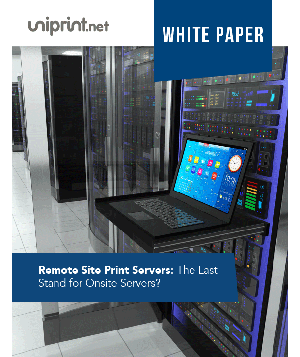What is Fault Tolerance? High Availability & Printing

The ability of a computer system, a cloud cluster, or a network to continue operations even when many components fail is known as fault tolerance.
A fault-tolerant setup typically consists of a system that has the ability to continue seamless operation even under circumstances where one or more of its components suffer from failure.
This is distinct from non-fault tolerant systems, where any component failure may result in total system collapse!
Fault tolerance tends to be in high demand in environments and industries where workflows and processes are critical and extremely time sensitive, such as in the healthcare and financial industries.
To achieve fault tolerance, infrastructure should be designed in such a way that failure states are considered, and appropriate systems are developed to deal with them.
Fault-tolerant systems should have no single point of failure and must be able to isolate the component suffering from failure and prevent any further spreading of the issue.
With redundancy being the backbone supporting fault tolerance, organizations cannot afford to adopt fault tolerance for all system components.
Before going ahead and implementing a fault-tolerant design, enterprises should consider the critical nature of the system component, the likelihood of failure, and the cost of implementing fault tolerance.
If the system needs are not as critical and the risk of failure is relatively low, due to the high costs of implementing fault tolerance, organizations may want to deploy high availability!
High Availability Vs Fault Tolerance
To put this in simple terms, the difference between fault tolerance and high availability can be summarized as follows: fault tolerance does not interrupt service, but it is very expensive, whereas high availability has very little downtime.
It is important to note that High Availability, as well as Fault Tolerance, have the same goal which is making sure that your application is always available without causing any degradation to your system. In spite of their similarities, there are significant differences between the two. It differs from one to the other in terms of its cost, design, level of redundancy, and response to component failures.
A high availability application aims to run for at least 99.999% of the time so that it is always available to users. Its structure ensures that if any one of its components crashes, the entire system will be able to recover quickly as a whole. Several redundant resources are available so that in the event of a failure of one, there will be the ability for another resource to continue the work.
In contrast, fault tolerance aims to keep your application up and running without interruption. In addition to the more complex design, it has higher levels of redundancy so it can withstand any faults that may occur to one of its components. Further, due to its redundant resources, it’s not only capable of tolerating any component fault, but it will also prevent performance impacts, data loss, and system crashes.
High Availability Software
High availability software ensures that infrastructure remains operational, and systems are available for the maximum amount of time.
High availability entails close to one hundred percent availability, being just a little weaker than fault tolerance, which is known as being one hundred percent available!
With fault tolerance being quite pricy, many companies opt for high availability instead when it comes to less time-critical tasks such as printing!
Printing environments without high availability setups typically suffer from complete outage of print services in the event of any single component failure.
With high availability software enabled, print servers are duplicated, so that in the event of a failure, print jobs are redirected to the available server and printing continues, guaranteeing minimized downtime.
The effectiveness of high availability software is determined by its performance during system component failure and its ability to get the system functioning again at a level close to that before the failure, in a manner that eliminates or significantly reduces system downtime.
Effective high availability software should be able to manage all sorts of faults affecting system availability, including both hardware and software issues!
Check out this free webinar on How to Achieve 24/7 Printing Up-time in Your Print Environment!
Clustering: Microsoft’s High Availability Solution
Microsoft deploys their own high availability program, or clustering service, known as the Microsoft Cluster Server, that provides server computers the ability to function in unison as a single computer cluster, providing greater availability for a wide range of services and applications, along minimized downtime.
Applications and services operate on shared resources, and in the event of failure, shared resources are automatically transferred from a failing server to an equally configured functioning server.
As Windows Server 2012 was released, Microsoft decided to continue the clustering service, however its implementation was restricted to vital tasks which were highly time sensitive.
However, when it came to print, Microsoft decided that it was time to eliminate the clustering service offered for printing, and instead offer virtualized high availability support for printing from Server 2012 onwards!
Virtualized High Availability: Microsoft Hyper-V
Since the advent of Windows Server 2012, Microsoft assigned support for high availability printing to its Hyper-V technology.
Hyper-V essentially virtualizes the print servers across two or more virtual machines, with the redundant machine functioning as a backup mechanism, being able to manage printing in a scenario where there is failure at the other machine.
This print server virtualization approach to high availability creates a live instance of the virtual machine, running on another physical server.
In case of a failure, the creation of a new secondary virtual machine is automatically triggered. One of the main concerns with this high availability setup is the downtime that occurs because of the failure and subsequent creation of another virtual machine.
Next Steps:
Organizations should assess their printing requirements and determine where they see themselves in terms of the high availability landscape.
In environments where time is of the essence, no printing downtime can be tolerated whatsoever, and the company budget can accommodate larger spending on IT infrastructure, it may be a better option to adopt a completely fault tolerant printing system.
In settings where enterprises can afford little downtime, high availability software may be the appropriate solution, offering close to one hundred percent availability.
Try UniPrint InfinityCloud
Whether you are printing at the office or at home, UniPrint InfinityCloud is the cloud printing solution of choice for your organization.
Recent Posts
- Why Traditional Printing No Longer Works In Your Office
- How to Streamline and Modernize Printing in Healthcare Environment
- When Print Management Becomes a Crisis: How to Act Fast
- 10 Ways Cloud Print Management Can Increase Security to Prevent Data Loss and Increase Productivity
- Serverless Printing 101: A Beginner’s Guide to Going Server-Free with Print
- Cloud Printing Management: The Secret to Fewer Help Desk Tickets
- Why Should You Outsource Printing Management? A Comprehensive Overview
- How Cloud Print Management Prevents Print Server Vulnerabilities
- Is Printing Dead?
- How InfinityCloud Outshines Microsoft Universal Print in 2024
- See All















